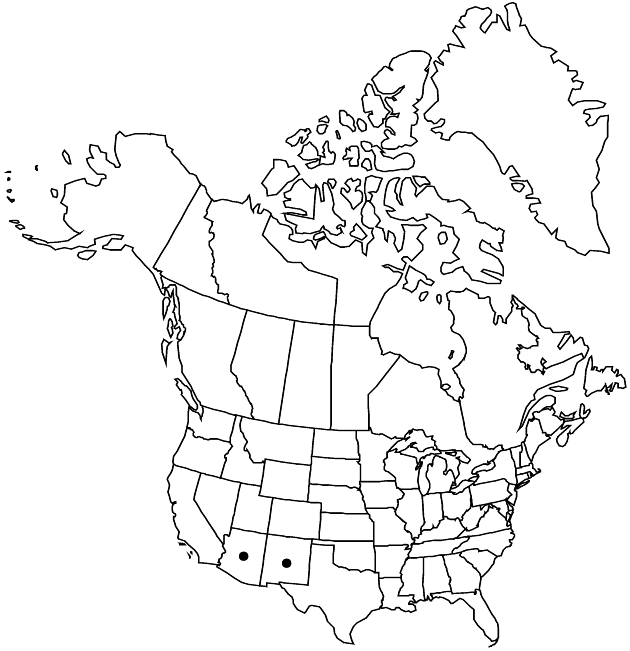Difference between revisions of "Erigeron oreophilus"
Proc. Amer. Acad. Arts 41: 257. 1905.
FNA>Volume Importer |
FNA>Volume Importer |
||
| Line 12: | Line 12: | ||
|name=Achaetogeron pringlei | |name=Achaetogeron pringlei | ||
|authority=Larsen | |authority=Larsen | ||
| − | }}{{Treatment/ID/Synonym | + | }} {{Treatment/ID/Synonym |
|name=Erigeron delphiniifolius var. oreophilus | |name=Erigeron delphiniifolius var. oreophilus | ||
|authority=(Greenman) Cronquist | |authority=(Greenman) Cronquist | ||
| Line 30: | Line 30: | ||
|elevation=1100–2800(–3100) m | |elevation=1100–2800(–3100) m | ||
|distribution=Ariz.;N.Mex.;Mexico (Chihuahua;Durango;Sonora). | |distribution=Ariz.;N.Mex.;Mexico (Chihuahua;Durango;Sonora). | ||
| − | |discussion=<p>Erigeron oreophilus is similar to E. neomexicanus in its perennial habit, typically pinnatifid leaves, white, reflexing rays, and 10–12 readily falling pappus bristles; it has a vestiture of dense, viscid, stipitate glands and sparse, spreading, nonglandular hairs.</p> | + | |discussion=<p><i>Erigeron oreophilus</i> is similar to <i>E. neomexicanus</i> in its perennial habit, typically pinnatifid leaves, white, reflexing rays, and 10–12 readily falling pappus bristles; it has a vestiture of dense, viscid, stipitate glands and sparse, spreading, nonglandular hairs.</p> |
|tables= | |tables= | ||
|references= | |references= | ||
| Line 54: | Line 54: | ||
|publication year=1905 | |publication year=1905 | ||
|special status= | |special status= | ||
| − | |source xml=https://jpend@bitbucket.org/aafc-mbb/fna-data-curation.git/src/ | + | |source xml=https://jpend@bitbucket.org/aafc-mbb/fna-data-curation.git/src/8f726806613d60c220dc4493de13607dd3150896/coarse_grained_fna_xml/V19-20-21/V20_562.xml |
|tribe=Asteraceae tribe Astereae | |tribe=Asteraceae tribe Astereae | ||
|genus=Erigeron | |genus=Erigeron | ||
Revision as of 15:24, 18 September 2019
Perennials, (8–)25–90 cm; taprooted, caudices woody. Stems erect, sparsely hirsuto-villous (hairs 0.6–2 mm) or glabrous, densely stipitate-glandular (at least on distal 1/2, glands relatively large, capitate). Leaves basal (sometimes withering by flowering) and cauline; basal blades 15–60 × 8–37 mm, cauline gradually reduced distally, margins deeply pinnatifid, lobes 2–4(–5) pairs, faces usually glabrous, stipitate-glandular. Heads (1–)5–25(–50) in loosely corymbiform arrays. Involucres 4.5–5.5 × 8–12 mm. Phyllaries in 3–4 series, glabrous or sparsely hirsute, densely stipitate-glandular. Ray florets 75–130; corollas white, 8–14 mm, laminae reflexing. Disc corollas 2.8–3.5 mm. Cypselae 1–1.2 mm, 2-nerved, faces sparsely strigose; pappi: outer of setae, inner (readily falling) of (8–)10–12 bristles. 2n = 18.
Phenology: Flowering Jul–Oct(–Nov).
Habitat: Open, rocky habitats, cliff ledges or crevices, grassland, chaparral, oak, pine, pine-fir
Elevation: 1100–2800(–3100) m
Distribution

Ariz., N.Mex., Mexico (Chihuahua, Durango, Sonora).
Discussion
Erigeron oreophilus is similar to E. neomexicanus in its perennial habit, typically pinnatifid leaves, white, reflexing rays, and 10–12 readily falling pappus bristles; it has a vestiture of dense, viscid, stipitate glands and sparse, spreading, nonglandular hairs.
Selected References
None.